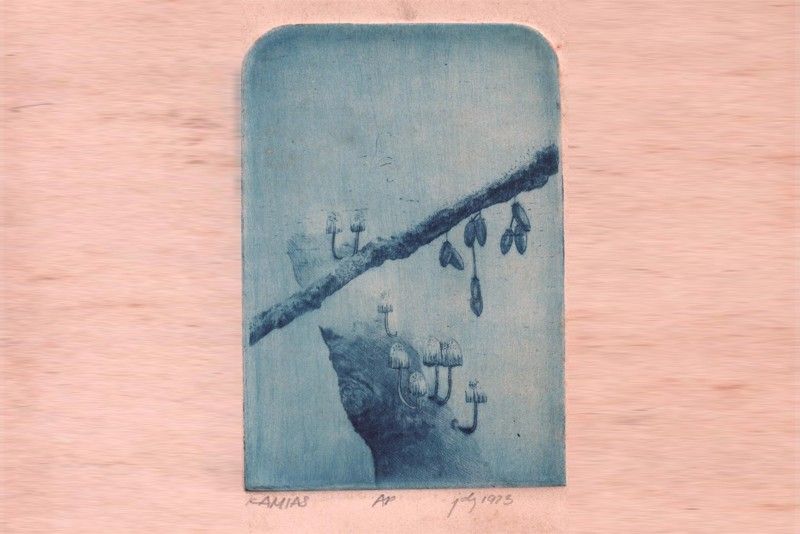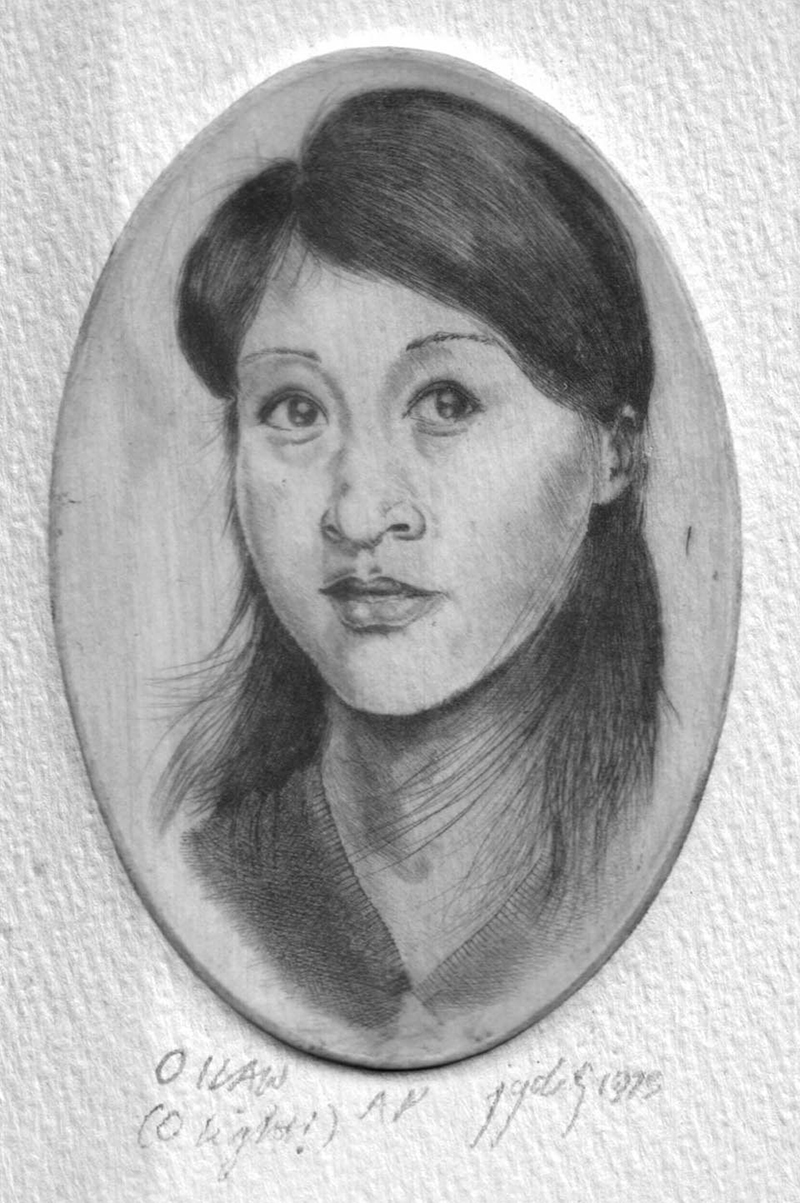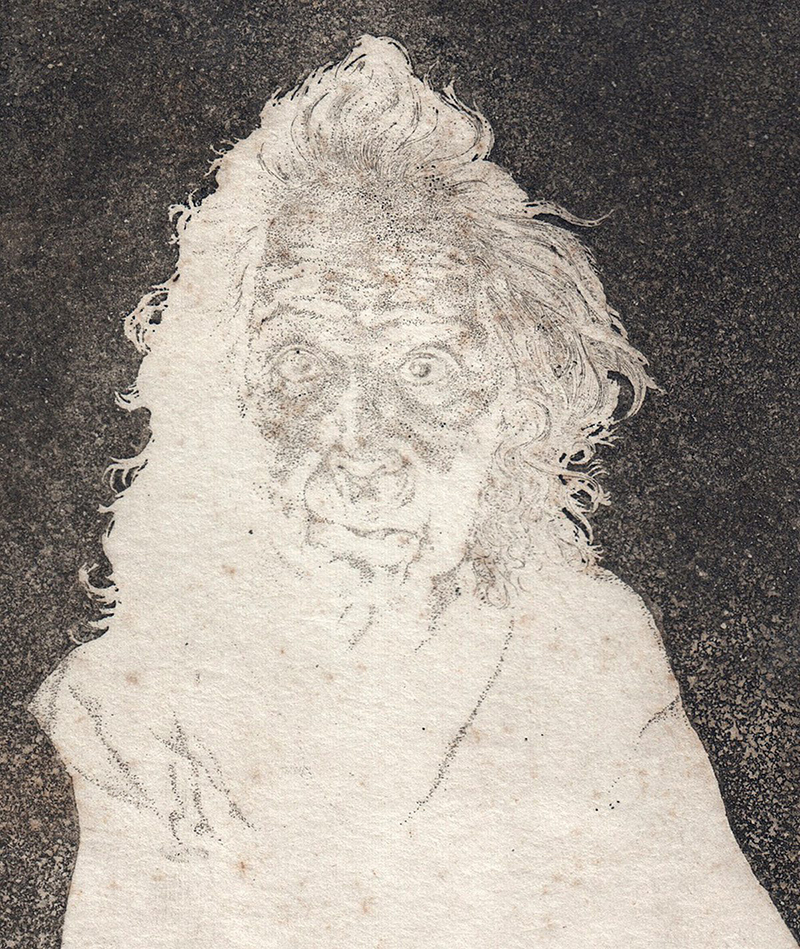My past as a printmaker

“Kamias,” by author Butch Dalisay (drypoint, 1975)
Among my fellow detainees was the artist Orlando “Orly” Castillo, who organized an artists’ group which conducted sketching sessions and painted and sold little souvenir items to our Sunday visitors.
Every now and then I get a reminder from somewhere very far that, at one point in my past, I led a very different life and might have gone down another path altogether.
Last month I received a message from a gentleman in England, asking me if I knew the artist of a print he had acquired, an etching of a water buffalo with a bird perched on his back, dated 1974, titled “Katuwaan Lang,” and signed by a “j y dalisay jr.” I received similar inquiries from two ladies in the States back in 2008 and 2015, who both sent me pictures of prints I hadn’t seen in decades.
Yes, I told them all, once upon a time I worked as a printmaker, and it happened this way.

“A Portrait of Beng” (drypoint, 1973)
In January 1973, I was arrested by the military for alleged subversion — I was 18, a college dropout, and a fledgling reporter for the Philippines Herald and Taliba — and was thrown, along with a couple hundred other inmates, into a detention camp somewhere in what people now smartly call Bonifacio Global City. Back then it was just the Ipil Rehabilitation Center, a repurposed Army barracks enclosed in barbed wire.
Among my fellow detainees — aside from the likes of Jojo Binay, Orly Mercado, and Zeus Salazar — was the artist Orlando “Orly” Castillo, who organized an artists’ group which conducted sketching sessions and painted and sold little souvenir items to our Sunday visitors. Not knowing how long we were going to be detained — I for one was never arraigned or tried in court, although I was interrogated and beaten up — I signed up with the group, having done a bit of drawing since grade school.
As it turned out, I would be released after seven months (“Go pack your backs, we have nothing on you,” said the officer). Instead of returning to school in UP—which I found deathly quiet and unconducive to learning — I sought out Orly, who had been released earlier, and joined him and a group of new friends at the Philippine Association of Printmakers studio and gallery at 1680 Jorge Bocobo Street in Ermita, Manila.
It was really little more than a big box at the far end of a lot, but it housed an etching press, and I learned printmaking on that press just by watching the regulars going through the motions of coating zinc plates with asphalt “ground,” drawing their designs on the ground, soaking the plates in a bath of nitric acid, inking the plates, and printing copies of the artwork off them under the rolling press. I looked over the shoulders of people like the late Manolito Mayo, Tiny Nuyda, Joel Soliven, Bing del Rosario, Fil de la Cruz, Ronald Veluz, and Emet Valente. (Yes, most of the regulars there were guys, although Petite Calaguas, Adiel Arevalo, and Ivi Avellana-Cosio would also come by.) Sometimes BenCab dropped in, and I was very happy when he remarked kindly on one of my etchings of a boat in Romblon harbor.
I did etchings like everybody else, but my preferred technique was drypoint, which meant scratching and digging the design straight onto the zinc plate with nothing more than the needle of a compass. My fingers would get so sore they nearly bled, but drypoint lent the work a certain delicacy of line that you couldn’t get with nitric acid. For inspiration, I turned to the pages of E. S. Lumsden’s 1926 classic The Art of Etching, a copy of which I still keep.

A portrait of Dalisay’s grandmother, Mamay (etching, aquatint, and drypoint, 1975)
I became a printmaker for a while, not just because I loved the craft and the company, but because I was jobless. Selling prints in bulk to a dealer who sold them framed to US servicemen sustained me through that lean season. The prints sold for maybe just 15 or 20 pesos each, but a few hundred went a long way then.
At some point I won an honorable mention for the drypoint print of a farmer, and served as vice president of PAP under Lito Mayo — not for any abundance of artistic talent (I was way too conservative to amount to much), but, I suspect, because of my way with words, a facility I have found useful to this day. But inevitably life’s other challenges caught up.
It was at the PAP where I met my wife to be, a pretty girl named June, and I courted her with letters handwritten with a Mars Lumograph and, of course, a drypoint portrait I made of her. A few months after we met, we were married — but not before I managed to find a more stable job, at my mother’s insistence, this time as a writer for the National Economic and Development Authority, just around the corner.
The PAP has long left J. Bocobo and all I have from those days is a small album of about a dozen stray prints, but I still feel a surge of fraternity whenever I meet BenCab, Tiny, Ivi, and the other true masters of the art. I like to think that I’ve ported my sense of imagery and detail to my writing. We can always hope that here or elsewhere, in whatever form, the art will survive the artist; ars longa, vita brevis.
* * *
Email me at jose@dalisay.ph and visit my blog at www.penmanila.ph.



















